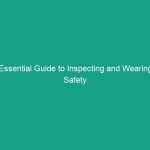Good Morning Team!
Today, we’re going to discuss an essential aspect of Workplace Safety that often gets overlooked: Dust Mask Fit Testing. This Toolbox Talk will guide you through the importance of ensuring a proper seal and protection when using dust masks. Understanding this topic not only safeguards your health but also enhances our overall Workplace Safety.
Understanding Dust Mask Fit Testing
Dust mask fit testing is the process of ensuring that a dust mask or respirator properly fits an employee’s face. This is crucial because a proper seal ensures that the mask can effectively filter out harmful particles in the air, protecting your lungs and overall health.
Many employees may think that any dust mask will provide adequate protection, but that is a misconception. A poorly fitting mask can lead to unfiltered air entering the mask, which can expose you to harmful substances.
Key Hazards, Risks, and Safety Considerations
Now, let’s discuss some specific Hazards and risks associated with inadequate dust mask fit testing:
- Respiratory Illness: Insufficient protection can lead to respiratory diseases over time, especially in environments with high dust or chemical exposure.
- Allergic Reactions: If allergens are not filtered out properly, employees may experience allergic reactions that can hinder productivity.
- Reduced Work Performance: If you’re not adequately protected, you may feel fatigued or unwell, impacting your ability to work effectively.
Ignoring proper fit testing can have serious real-world consequences, including chronic health issues and increased absenteeism due to illness.
Best Practices, Procedures, & Actionable Advice
To ensure your dust mask fits correctly, follow these steps:
1. Choose the Right Mask
Start by selecting a dust mask that is appropriate for the specific hazards present in your work Environment. Consult with your supervisor or Safety officer if you are unsure.
2. Conduct a Fit Test
A fit test should be conducted by a trained professional. There are two main types of fit tests:
- Qualitative Fit Test: This test uses a test agent (like a sweet or bitter solution) to determine if the wearer can detect the agent, indicating a poor fit.
- Quantitative Fit Test: This test measures the actual amount of leakage into the mask using specialized equipment.
3. Perform a User Seal Check
Every time you put on a dust mask, perform a user seal check. This involves:
- Covering the mask with both hands and exhaling sharply. If air leaks around the edges, readjust the mask.
- Inhaling sharply to ensure the mask pulls tightly against your face.
4. Maintain Your Mask
Regularly inspect your dust mask for damage or wear and replace it as necessary. A damaged mask cannot provide proper protection.
Case Study: Real-World Incident
In a recent incident at a construction site, an employee suffered from severe respiratory issues due to a poorly fitting dust mask. The mask did not create a proper seal, allowing harmful dust particles to enter. This case highlights the importance of fit testing and regular inspections.
Regulations, Standards, and Compliance
Compliance with safety Regulations is non-negotiable. In the U.S., OSHA (Occupational Safety and Health Administration) mandates that employers provide appropriate respiratory protection and ensure fit testing is conducted. Failure to comply can result in severe penalties and, more importantly, jeopardize employee safety.
Additionally, familiarize yourself with your company’s specific safety protocols and ensure they align with industry Standards. This not only protects you but also creates a safer work environment for everyone.
Employee Engagement & Discussion
As we wrap up, I want to hear from you. Have you encountered any challenges related to dust mask fit testing? What measures do you think we can implement to improve our safety practices? Your feedback is invaluable in enhancing our safety programs.
Conclusion & Key Takeaways
In conclusion, proper dust mask fit testing is crucial for your safety and health. Remember to:
- Select the correct mask for your work environment.
- Conduct fit tests regularly.
- Perform user seal checks every time you wear a mask.
- Maintain and replace your masks as needed.
Prioritizing these practices not only protects you but also contributes to a safer workplace for everyone. Thank you for your attention and for your commitment to safety. Let’s keep our work environment healthy and secure!


